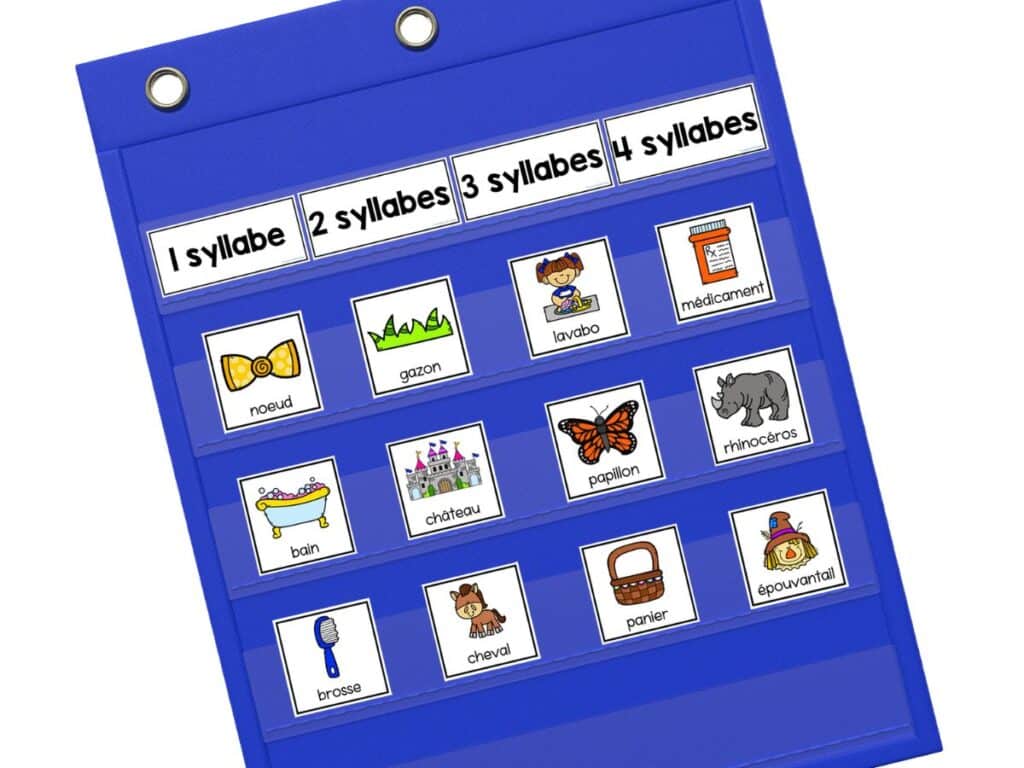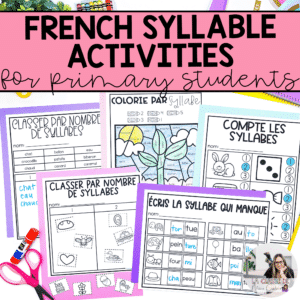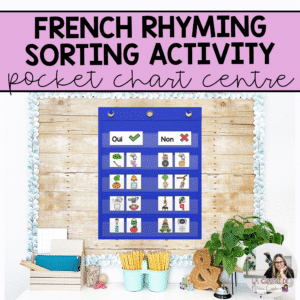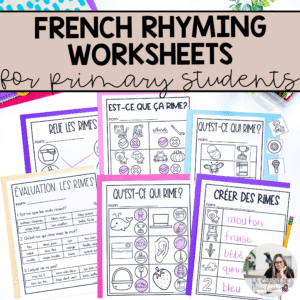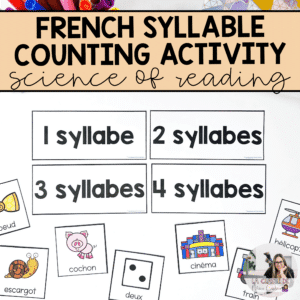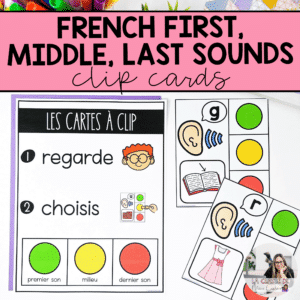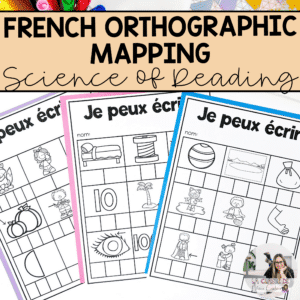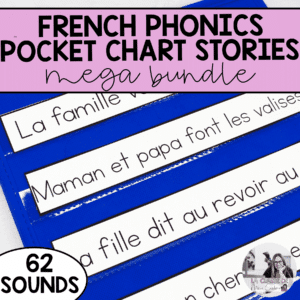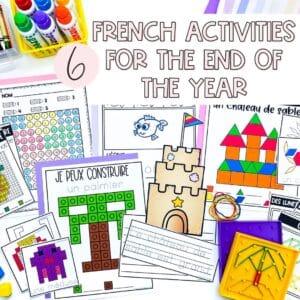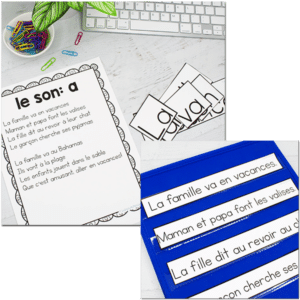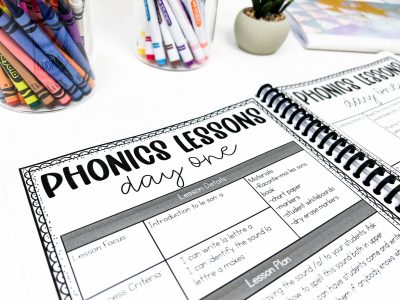Explore Science of Reading activities in French within the evolving landscape of education. There’s a growing focus on evidence-based practices, especially in teaching reading. The Science of Reading is a key player, providing a research-backed approach to build strong foundational skills in students.
If you’re struggling to incorporate these principles into your teaching without extensive workshops or prior exposure to the research, don’t worry! This guide shares 20 activities aligned with the Science of Reading that can be easily integrated into your classroom, whether you prefer small-group instruction or whole-class engagement.
Whether your students struggle with French sounds, mix up look-alike words, or need a comprehension boost, this guide has you covered. French teachers may feel left out when English homerooms get new resources, workshops, and strategies, but fear not! I delved into the research to find engaging phonics, vocabulary, and comprehension builders to make your students more proficient in French.
We all get stuck in textbooks and worksheets when creativity runs dry. But these practical ideas are here to help. From small group activities to full lessons, there’s something for every class. Get ready to engage your students and boost their literacy skills with Science of Reading activities in French!
Oh, and by the way, some of these links may be affiliate links. This means I get paid a commission for any purchases you make, but this doesn’t affect your price. This helps me keep posting resources like this sustainably! Check out my full disclosure here.
List of Science of Reading Activities in French
#1 – Phoneme Counting
To kick off our journey into French Science of Reading activities, let’s start with a foundational skill: Phoneme Counting. Have your students place their fists on their chests, say a word, and then guide them to segment the word into its individual sounds by lifting a finger for each phoneme.
Counting these phonemes with their fingers helps reinforce the understanding of sound units in words, paving the way for phonemic awareness. It’s a hands-on for them to practice breaking down tricky French words into individual sounds.
More engagement simply means better learning (and you’ll hear that a lot throughout these tasks). That’s really the gist of what you should be aiming for. Engaging children in a way that brings their attention to you, what you’re saying or doing, and the information you’re providing.

#2 – Sand Trays
Sand trays are another great hands-on way to work on French phonological awareness. Say a letter sound, like /b/, or a vowel combination, such as /eu/ and have students write the letter (or letter combination) in the sand.
This tactile learning activity also lets me instantly spot if anyone struggles with proper letter formation. Once they have the sounds down, you can have them practice writing simple words and short sentences. The possibilities are endless!
Research shows that multi-sensory activities, like using sand trays or playdough helps students with retention. Don’t be scared to make your French Science of Reading activities fun!
#3 – Rhyming Sorting
Working on rhyming words provide an excellent opportunity for students to recognize patterns in ending sounds. Utilize pocket charts to make this Science of Reading activity in French interactive and dynamic.
Categorizing words physically aids retention and cements phonetic patterns. The interactive format of a pocket chart activity also keeps them engaged since you can get them out of their seat to place the cards themselves.
By physically sorting cards and identifying whether word pairs rhyme or not, students actively engage with rhyming concepts.
According to research, building literacy through play-based activities has incredible benefits for young minds, so it’s well worth thinking about how you can bring this into your classroom. Sorting games are an easy way to ensure rhyming sticks!
#4 – Phoneme Clip Cards
Clip cards are perfect for your French centres or small-group phonics games. Students identify specific sounds in words—whether they appear at the beginning, middle, or end. This activity enhances sound recognition and provides a tangible resource for focused practice.
Phoneme clip cards are a great way to practice phoneme identification. Each card displays a vocabulary word with a target sound. Students need to identify if the target phoneme is a beginning, middle, or ending sound.
Phonemic awareness is a key skill needed in order to learn to decode words, making this French Science of Reading activity perfect for your classroom!
#5 – Flip Book Reading
I use a simple yet engaging DIY tool to help students master blending consonants and vowels – the old spiral notebook! Turned sideways, these become “flip books” to reveal endless letter teams.
Cut the pages in half, while still keeping them connected to the binding. Write consonants on the left pages, and vowels on the right. Flip the pages around to continue creating new CV syllable combinations to read.
This setup allows for repeated use, reinforcing CV combinations and promoting fluency. I have students sound out each made-up fusion aloud, reinforcing how to blend phonetic components quickly. This flip book hack is an easy to set up, but extremely effective Science of Reading activity to work on decoding skills.

#6 – Orthographic Mapping
One activity that truly unlocks the power of phonics is orthographic mapping. This technique has created so many “lightbulb” moments for emerging readers and writers!
To practice orthographic mapping in French, say a word out loud and have students segment the phonemes found in the word and write them on their whiteboard.
They write each separate sound in a box to construct the word. This helps them create links between phonemes (what they hear) and graphemes (what they read). Orthographic mapping is an excellent French Science of Reading activity for both reading and writing proficiency.
The strategy drives home direct print-to-sound connections essential for decoding fluency. I can’t overstate the value – orthographic mapping is an absolute triumph for young readers ready to blossom!
#7 – Phoneme Addition
Challenge your students by working on phoneme manipulation, starting with phoneme addition. This is the easiest phoneme manipulation skill to master, and it’s quite literally what it sounds like – adding a phoneme to a word in order to create another word. This activity helps students grasp how inserting sounds transforms words.
Say a word, then instruct them to add a specific phoneme at the beginning or end to create a new word. For example, start by clearly saying a word, like “nage.” Next, have your students add a new sound to either the beginning or the end, like adding /er/ at the end. They’ve now transformed the word nage into nager.
Initially, sound out the transformations out loud. Once they’ve nailed this, everyone grabs whiteboards to write out their words. This pushes them from oral to written mastery.
What’s more, the French Science of Reading activity also cements understanding of phoneme manipulation – a key to decoding unfamiliar vocabulary.
#8 – Syllable Sorting
Identifying syllables in words is a part of French phonological awareness. It’s one of the basic skills that students need to master in order to learn how to decode. The ability to segment words into syllables helps with decoding because they can transfer this skill to help them break down unknown words when reading.
One way to practice syllable segmentation is by using a pocket chart centre. Quite simply, using printed word cards, I have students clap out and count the syllables they hear aloud in unison first. Understanding the aural breakdown of words comes first.
Next, they sort the words into the column that matches the number of syllables. You can do this as a whole-class activity by doing it out loud together, or you can pass out the cards to your students and have them sort their cards into the chart.
This activity is also great to use as a centre or even in your small-group learning! This is one of my favourite French Science of Reading activities to do with my students. It really helps solidify their understanding of syllables.
#9 – Counting Phonemes with Pop-its
Embrace multi-sensory learning with Pop-Its, turning the counting of phonemes into a hands-on experience. Pop-it toys have become staples in most classrooms thanks to their ultra-tactile appeal, but they also provide an engaging way to work on various skills!
Say a word, and have students push down on a bubble for each sound. This interactive center can also be adapted for counting syllables, providing a versatile resource.
These are my favourite Pop-its because they’re 10-frames so you’ve got enough bubbles for counting phonemes, but you can also double up and use them in your math block.
#10 – Phoneme Subtraction
Phoneme Subtraction is a phoneme manipulation skill necessary for reading success. It involves quite literally removing a phoneme from a word in order to create a new word.
There are 2 ways you can do this:
- The first way is by having students identify the phoneme you’ve removed from a word. For example, say the word blé. Then say the word les. Which phoneme was removed? It was the /b/ sound.
- The second way you can practice this skill is by saying a word and identifying a phoneme you want them to remove. For example, say the word boeuf, and ask students to remove the /b/ sound. What’s the new word? Oeuf.
Remember, the words don’t need to be spelt the same. This activity is done orally and relies on the sounds found in various words, not their spelling.
#11 – Letter-Sound Matching
Students need to know their letter sounds in order to be able to learn to read in French. Put out letters on the carpet or on your u-table, depending on if you’re doing this letter recognition activity as a whole-group or small-group activity.
Make a sound and have students find the letter that corresponds with the French phoneme. You can do this in many ways: you can have them play splat, or even as a team game. The opportunities are endless!
The lively interaction helps build letter-sound fluency. Students learn from both mistakes and triumphs in a supportive environment. Peer teaching reinforces connections, too.
Rather than heavy competition, the goal is enjoyment and growth in alphabet skills. By tackling many letter-sound pairs rapidly, students gain the confidence to decode unfamiliar words without undue pressure.
Adaptations like timers or teams can add a challenge for students who are beginning to master their letter sounds.
#12 – Word Building Using Magnetic Letters
Orthographic mapping doesn’t always have to be done paper to pencil. Grab cookie sheets and magnetic letters to practice building words. You can even create Elkonin boxes on your cookie sheets using electrical tape.
You can either say a word out loud or you can show students a picture to add more French vocabulary word practice. Then have them build the word on their cookie sheet, mapping out the sounds in the Elkonin boxes.
This Science of Reading activity in French is great for making connections between phonemes and graphemes in a hands-on, and paperless way.

#13 – Phoneme Blending
Blending phonemes into words is an essential early literacy skill. I’ll slowly pronounce segmented words, phoneme by phoneme (e.g. /l/-/a/-/c/). Students listen to the French phonemes you say, and then blend the sounds together to make the word (lac).
Start slow, with words that only have 2 or 3 phonemes, then practice blending longer words as your students’ skills grow.
#14 – Phoneme Segmentation
This French Science of Reading activity is the opposite of the last one. Instead of blending French phonemes into a word, they will identify the sounds in each word.
To practice this skill, say a word out loud and have students identify the phonemes they hear. For example, they would segment “château” into /ch/-/â/-/t/-/eau/. Like when you’re practicing blending words in French, start with small words and then move up to more complex words as they master the skill.
#15 – Syllable Worksheets
Breaking words into syllables aids literacy development across ages and abilities. Printable worksheets can provide focused opportunities to hone this skill.
Practice this phonological awareness skill through a variety of activities that allows students to count, sort, compose and decompose syllables. Do this as an independent whole-class activity, or use it during your small-group learning.
#16 – Shared Reading
Building fluency is crucial, and shared reading offers an effective approach. Reading out loud, engaging in shared readings, and repeated readings contribute to fluency development.
Have students practice reading by repeating after you, reading with you, or even reading one at a time. Continue revisiting the same stories over and over again to build fluency.
You can also use French shared readings to do other targeted practice, such as finding a specific sound in the story, identifying the number of syllables in various words, etc. Analyzing recurring literary elements as a supportive group makes decoding increasingly intuitive.
Looking for some phonics-based pocket chart stories to use with your class? Check out this bundle of stories that each target a different sound!
#17 – Vocabulary Games
The Science of Reading activities in French aren’t all about phonics – it’s also about comprehension! And language comprehension can’t happen without vocabulary knowledge, which isn’t as simple in a second language as it is in a first language!
Recognizing that reading comprehension relies on vocabulary knowledge, incorporate vocabulary-building activities. In a second language setting, these games become essential for ensuring students not only decode words but also understand their meanings.
Students don’t come into class knowing the vocabulary, you need to teach it to them. If students can decode, but they don’t know what the words mean, they won’t be proficient readers.
A great way to work on vocabulary building is by playing vocabulary games. Your students will love the hands-on aspect, and you’ll love how much they’re learning while having fun!
The goal is engagement with language, not just memorization. Tailoring these games to different classes prevents boredom while expanding skills, and that’s precisely what we should be doing as teachers!
#18 – Decodable Reading
Once your students are ready to read independently, you should use French decodable reading passages. These contain a high percentage of words that can be sounded out based on the phonics skills and sounds they’ve learned.
Remember, a decodable passage is different for every student – it’s based on what they know and what they can read, not necessarily what you’ve taught them. Some might be ahead and know more than what you explicitly taught, and some might be behind.
Decodable reading passages in French are a great way for students to practice independent reading, that you can differentiate to their level. Then reinforce comprehension skills by having students answer the questions included on each page.
#19 – Story Retelling
Assess comprehension through Story Retelling. Reading comprehension isn’t only about comprehending texts that your students can read independently – it’s also comprehension of texts you read out loud to them.
Whether reading a story aloud or allowing students to read independently, story retelling in French gauges their understanding and ability to convey information coherently. It supports text comprehension—a crucial aspect of becoming proficient readers.
Story retelling can be done either orally, or in writing. Oral retell involves students summarizing the story, while a written retell can involve identifying key elements of the story, such as the plot, setting, characters, and more.
#20 – Rhyming Worksheets
Foster rhyming skills by working on the simplest skill: yes/no rhyming questions to the most difficult to master: generating rhymes. Teaching rhyming in French is important because it helps students see patterns between the ending of various words.
These French rhyming activities cater to various skill levels, offering a scaffolded approach to mastering rhyming concepts. They offer fluency reinforcement and help students master this important phonological awareness skill. Pages with missing rhyme endings or matched rhyming pairs cement phonics concepts through writing-focused repetition.
Want to check out the resources listed?
All the links above lead to TPT, but the resources are also available on our website. Here are the resources available here for purchase in CAD. Don’t forget you can also buy credits for an additional discount (up to $15 off).
-
Sale Product on sale
 French Decodable Reading Passages & Comprehension Questions Full Year Bundle
French Decodable Reading Passages & Comprehension Questions Full Year Bundle$ 68.00Original price was: $ 68.00.$ 54.50Current price is: $ 54.50. -
 French Syllable Worksheets and Assessment for Primary Students | Les syllabes$ 5.50
French Syllable Worksheets and Assessment for Primary Students | Les syllabes$ 5.50 -
 French Rhymes Pocket Chart Centre | French Phonological Awareness Activities$ 4.00
French Rhymes Pocket Chart Centre | French Phonological Awareness Activities$ 4.00 -
 French Rhyming Worksheets and Assessment for Primary Students | Les rimes$ 5.50
French Rhyming Worksheets and Assessment for Primary Students | Les rimes$ 5.50 -
 French Syllable Counting Activity | French Phonological Awareness Activities$ 4.00
French Syllable Counting Activity | French Phonological Awareness Activities$ 4.00 -
 French First, Middle, Last Sound Clip Cards | French Phonological Awareness$ 4.00
French First, Middle, Last Sound Clip Cards | French Phonological Awareness$ 4.00 -
 French Orthographic Mapping by Sound | La cartographie orthographique$ 8.50
French Orthographic Mapping by Sound | La cartographie orthographique$ 8.50 -
Sale Product on sale
 French Phonics Pocket Chart Stories | Mes histoires des sons | MEGA BUNDLE
French Phonics Pocket Chart Stories | Mes histoires des sons | MEGA BUNDLE$ 80.00Original price was: $ 80.00.$ 40.00Current price is: $ 40.00.
Conclusion
Incorporating the Science of Reading into your French Immersion classroom doesn’t have to be overwhelming. By integrating these 20 French literacy activities, you provide your students with a diverse and engaging toolkit for developing essential phonological awareness skills.
Stories, rhymes and sharing sessions boost comprehension and excitement, too. Most importantly, a supportive environment centred on collaboration allows each student to blossom.
Whether in small groups or as whole-class activities, these strategies align with the research-backed principles of the Science of Reading, fostering a solid foundation for literacy success.
Remember, each student’s learning journey is unique, and these activities offer flexibility for differentiation. Embrace the journey of literacy instruction with confidence, knowing that you’re equipped with evidence-based practices to nurture the next generation of proficient readers.
Looking for more? Check out my other posts about the Science of Reading in French to find activities, strategies, and more!





